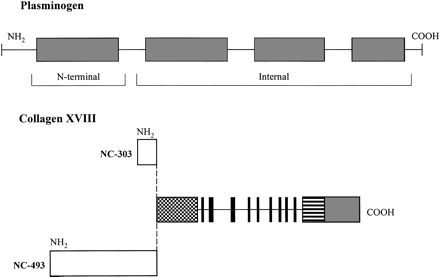Homeostatic Control of Angiogenesis: A Newly Identified Function of the Liver?
Fig. 1. Schematic representation of plasminogen and collagen XVIII and their cryptic fragments with angiogenesis inhibitory activities. Plasminogen: The N-terminal and internal fragments of angiostatin (gray boxes) include the first four of the five disulfide-linked structures of plasminogen, known as kringle structures. Collagen XVIII: The two N-terminal end variants of human collagen XVIII have noncollagenous domains fo 493 (NC-493) and 303 (NC-303) amino acids, respectively. Human hepatocytes express the NC-493 variant at high levels. Both variants share the C-terminal residues of the N-terminal NC domain (stippled box), the collagenous domains (full line), the noncollagenous interruptions (black boxes), and the C-terminal noncollagenous domain of the molecule (horizontal lines) containing endostatin (gray box).





